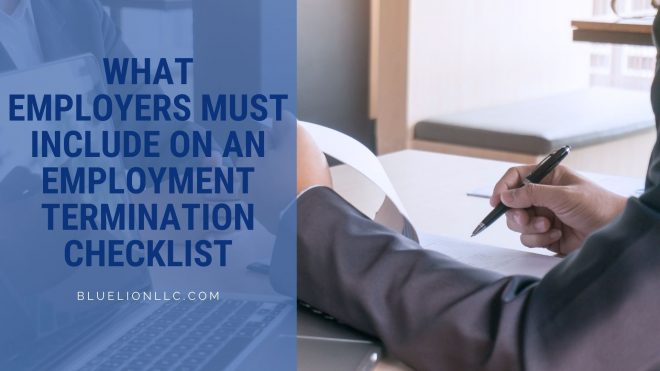
Whether you just hired your first employee or you are already managing a growing team, it’s never too late to put an employment termination checklist in place. After all, terminations are difficult enough as it is—every organization could use a tool to make employee separations that much easier.
Your termination checklist serves as a master list of the things you, your leadership, and your HR team need to do when an employee leaves the company. You should refer to this list for employee resignations, layoffs, or firings.
That’s why we’re sharing the importance of having an employee termination checklist along with a template, which even includes some helpful tips and definitions.
Why is it important to have a termination checklist?
Terminating an employee can be a sensitive, stressful process. Even in the case of a resignation, employers need to ensure they remain compliant and don’t miss any important steps. An employment termination checklist will help you:
- Create a smooth transition for the employee and the rest of your team.
- Protect your business against possible future legal issues.
- Ensure you provide separated employees with all required termination documents.
Employment Termination Checklist Template + Tips
Basic Termination Information
___ Create termination documents: This should include:
- Employee’s name
- Job title
- Last day of employment
- Department they worked in
- Reason for termination
- Employee/company number (if applicable)
- HR person working on the termination
- Date of termination checklist completion
Human Resources Involvement
___ Notify HR
___ Consult with HR to notify other relevant employees and individuals:
- Receptionists
- IT
- Security
- Union
- Bank/Credit Union
- Mobile provider
- Insurance provider
- Professional associations
- Customers/clients the employee is currently working with
___ File employee files & termination documentation in terminated employee files:
- Personnel file
- Form I-9
- Termination letters
- Receipts for returned items
- Documentation for disciplinary action, warnings, and performance reviews that support your firing of the employee
Termination Type
Voluntary Termination: If an employee ends the working relationship, employers must:
___ Obtain employee resignation letter: If an employee gives a verbal resignation, request a written resignation letter immediately for your records.
Involuntary Termination: If you fire or layoff an employee, be sure to:
___ Provide employee with termination letter (for-cause terminations)
___ Provide employee with severance agreement (if eligible for layoff and severance)
___ Receive signed severance agreement (if applicable)
___ Provide employee with WARN/OWBPA notices (if applicable):
- Worker Adjustment and Retaining Notification (WARN): Ensures advanced notice in cases of qualified plant closings and mass layoffs
- Older Workers Benefit Protection Act (OWBPA): Protects workers from age discrimination by specifically protecting their benefits
Learn about the different types of termination.
Exit Interview
If an employee leaves voluntarily, employers should hold an exit interview.
___ Conduct an exit interview: An exit interview is a confidential meeting with the departing employee and HR meant to provide insight to your company’s work environment and communicate important employment separation information to the employee.
___ Allow the employee to share their work experience: Ask them how they:
- Related to their coworkers
- Felt about their work and the environment
- Viewed conditions and company practices
___ Review final pay policy
___ Inform employee on how to return company property.
___ Provide letter reminding employee of legal agreements that continue post-employment, including:
- Noncompete
- Nondisclosure
- Confidentiality
- Non-solicitation
- Intellectual property
___ Obtain a signed authorization to respond to employment verification requests
___ Verify & update information: Confirm the employee’s address, contact information, and emergency contact information (whom you can contact to find the right address if necessary). Provide them with a form to update their address if they move within the next year. This is crucial for important tax and other forms, like W2s.
IT Matters
___ Notify IT staff: Inform your network administrator and IT team when to terminate the employee’s computer, network, and phone access.
___ Remove employee from email distribution and phone lists
___ Migrate clients (if applicable): Determine who will take over the ex-employee’s accounts to ensure you do not lose any clients or contact information. Typically, organizations keep former employees’ phone lines and email accounts live for 60 days to avoid missing important business communication.
___ Clear data & reset devices: Your IT department should check and erase the ex-employee’s computer, tablet, and/or phone so they are ready for future employee use.
Building Access & Property
___ Disable security code(s): Disable the former employee’s building codes on their final day. If everyone uses the same codes, change them and remember to update the rest of your staff. Be sure to do this immediately if you fire the employee.
___ Disable their key card
___ Change office mailbox
___ Clean work area and remove the employee’s personal belongings
Collect all applicable company property, including:
___ Keys (including office, building, desk, filing cabinets, etc.)
___ ID card
___ Building access card
___ Business cards
___ Nameplate
___ Name badge
___ Company cell phone
___ Laptop
___ Uniforms
___ Tools and equipment
___ Company software
___ Company vehicle
Add items specific to your company/industry to create a comprehensive employment termination checklist.
Benefits
___ Provide a benefits status letter: Employers should provide departing employees with a letter indicating the status of their benefits, including when coverage ends. This should address benefits like COBRA, life insurance, supplemental.
___ Check and notify employee of remaining FSA/HSA funds and reimbursement deadlines (if applicable)
___ Check and notify employee of remaining DCAP funds and reimbursement deadlines (if applicable)
- Dependent Care Assistance Plan (DCAP): Employee benefit plan that helps employees pay for the care of a qualifying dependent (i.e., someone who lives with the employee and is 12 years of age or younger, OR someone 13 or older who is physically or mentally incapable of self-care and regularly spends at least eight hours a day in the employee’s household)
___ Check and notify employee of PTO balance and how it will be processed upon employment termination
___ Inform employee about retirement plan options
Final Compensation
___ Provide notice of payroll advance repayment policy: Unpaid payroll advances, travel advances, and educational loans should be withdrawn from the employee’s final paycheck.
___ Notify payroll to process final paycheck: The final pay should include any earned unpaid/unused:
- Wages
- Commission
- PTO balance
- Business expenses that they submitted on an expense report
- HSA/FSA balances
___ Notify payroll to process severance pay and specify if lump sum or salary continuation (if applicable)
___ Issue the final paycheck: Check your state laws to ensure you send the employee’s final paycheck within the required time and through an accepted method.
Do you need help creating your employment termination checklist or managing the overall process? Contact BlueLion today at 603-818-4131 or info@bluelionllc.com and our HR professionals will gladly review your processes and policies to ensure compliance and positive employee relations.
The information on this website, including its newsletters, is not, nor is it intended to be, legal advice. You should contact an attorney or HR specialist for advice on your individual situation.


